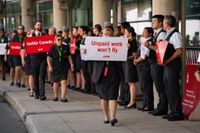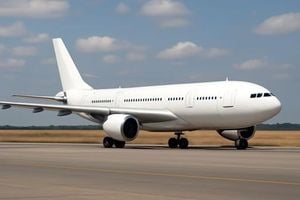For thousands of Canadians, the end of Air Canada’s flight attendants’ strike on August 19, 2025, brought a sigh of relief—at least, for some. After days of chaos, missed connections, and mounting frustration, the country’s largest airline struck a tentative agreement with its union, promising a gradual return to normal operations. But as travelers trickled back into airports, the aftershocks of the disruption continued to ripple, leaving many still stranded, exhausted, and searching for answers.
The strike, which began on August 16, 2025, saw more than 10,000 Air Canada flight attendants walk off the job after months of stalled negotiations over compensation and working conditions, according to The Conversation. The immediate fallout was staggering: hundreds of flights grounded, more than 100,000 passengers stranded, and a travel network left in disarray. At the height of the crisis, about 130,000 travelers faced cancellations each day, with airports from Toronto to Vancouver swelling with frustrated would-be fliers.
For many, the ordeal began with an abrupt email—flights canceled at the last minute, no explanation, and no sign of help from Air Canada’s overwhelmed customer service lines. “Customers like me are in a state of limbo, with no ability to make a case to Air Canada and no way of receiving help,” said Mike Fulga, who was stranded in Greece, as reported by The Toronto Star. His story echoed across continents, as Canadians abroad scrambled for alternative routes home, often at great personal cost and with little guidance.
Missed weddings, funerals, and dream vacations became the new norm. Noha Zaher and Ibraheem Sabry, for instance, endured nearly 60 hours of travel chaos and confusion after their flights were abruptly canceled. Pete Attfield, a 56-year-old visiting family in the U.K., described his ordeal as “a roller coaster.” He recounted, “At 5 a.m. I learned my return flight to Ottawa was cancelled. Hours later, reports of a deal raised his hopes, only to have them dashed by an airline email confirming the cancellation.” His frustration was palpable: “How is it possible that the airline can just abandon its customers? In my opinion, they have not demonstrated due diligence or due care.”
For some, the only option was to improvise. Steve Marcotte, on vacation in Ontario, booked last-minute flights to Halifax to visit his son before returning home to Newfoundland—a detour that cost him thousands of dollars out of pocket. Kathy Keogh, whose Alaska cruise ended with a canceled flight in Vancouver, weighed the prospect of a costly hotel stay against the possibility of renting a car and driving home. “Yesterday was like, what are we going to do? And then you have the other airlines that were price gouging. It was disgusting,” Keogh told The Toronto Star. Fortunately, she awoke to the “exciting” news that the strike was over and she was rebooked for a Tuesday afternoon flight.
Air Canada’s leadership has acknowledged the deep impact of the disruption. “We are deeply apologetic for the impact that this disruption is having on our customers,” said Mark Nasr, the airline’s chief operating officer. “Right now, we’re focused on rebuilding the trust and the respect, and that will happen with time.” On August 19, 2025, Air Canada announced plans to resume operations for both Air Canada and Air Canada Rouge, with the first flights scheduled for Tuesday evening. However, the airline warned that a full return to regular service could take up to a week or longer, with some flights still subject to cancellation as the network stabilized.
To manage the backlog, Air Canada mobilized 5,000 staff to assist with customer rebookings and promised to upgrade digital tools, including a dashboard showing real-time flight operation data on its website. The airline also offered affected passengers options for full refunds, credits for future travel, or rebooking on other airlines where possible. “Only customers with confirmed bookings whose flights are shown as operating should go to the airport,” the airline cautioned, seeking to avoid further congestion and confusion.
The strike’s resolution came after a marathon nine-hour negotiation session, mediated by a third party and spurred by mounting pressure from the federal government and public opinion. The union, representing more than 10,000 workers, hailed the tentative agreement as a “transformational change for our industry,” declaring on its website, “Unpaid work is over. We have reclaimed our voice and our power.” The terms of the deal remain undisclosed pending a ratification vote by union members, but Air Canada’s Nasr asserted that it would make the airline’s flight attendants the best-compensated in Canada and “put an end to unpaid work at Air Canada.”
The dispute had reached a fever pitch over unpaid duties performed before takeoff, with the union defying back-to-work orders from the Canada Industrial Relations Board and continuing its picket line despite the strike being declared illegal. CUPE, the union representing the attendants, insisted that “a transformational change” had been achieved, while the government announced a probe into unpaid work in the airline sector, expected to take six to eight weeks.
For those still stuck in terminals or far from home, the aftermath is far from over. Air Canada admitted that it would only be operating about 53 percent of its flights on the first day back, moving roughly 35,000 customers. The process of rebooking, rerouting, and refunding could stretch on for days, if not weeks, leaving many in a state of uncertainty.
Experts say the stress of such mass disruption is not to be underestimated. Jean-Nicolas Reyt, a management professor at McGill University, noted in The Conversation that three powerful stressors—uncertainty, lack of control, and crowding—combined to make the situation “overwhelming even for the most patient individuals.” Research shows that people in these scenarios often lash out, sometimes at front-line staff who have little control over the root causes of the disruption. Reyt offered practical advice for coping: remember the problem is collective, not personal; focus inward to manage stress; and treat staff with respect to improve chances of receiving help.
As the dust settles, some passengers have taken legal action, joining a class-action lawsuit against Air Canada over its handling of the crisis. Meanwhile, the government’s promised investigation into unpaid work could have far-reaching implications for labor standards across the airline industry.
For now, the hope is that lessons will be learned—by airlines, unions, and policymakers alike. While the skies above Canada are getting busier again, the memories of this summer’s travel ordeal will linger for many, shaping expectations for how such crises are handled in the future.






